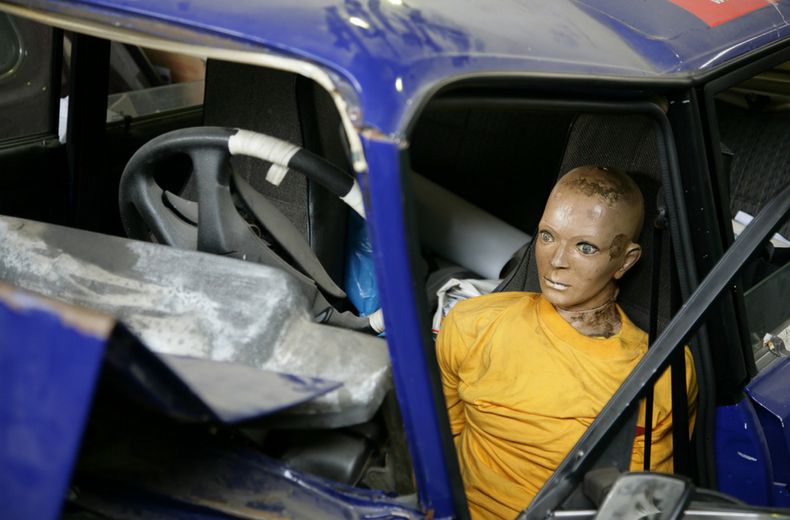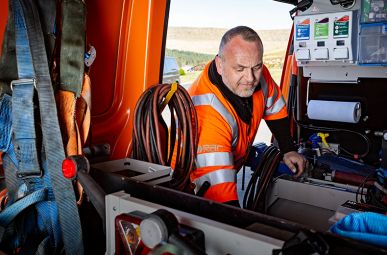Here we round up some of the most surprising facts about cars, motoring and motorists that may well leave you scratching your head in disbelief.
1. Real people were used as crash test dummies
Earlier this year, shocking online footage surfaced showing humans being used as car crash test dummies in Germany as recently as the 1970s.
The video revealed real people being battered and thrown around in crash simulations in a lab.
They’re seen smashing into cars driven by other people on icy roads and slamming into trees.
Another test shows a car ploughing into two stationary vehicles on a test track.
The footage was originally aired on the American ABC TV series Ripley's Believe It or Not in 1985.
Astonishingly, none of the drivers appeared to be seriously harmed – despite the vehicles suffering severe damage.
READ MORE: MOT checklist and comprehensive guide

RAC sale – up to 33% off*
• Roadside cover from £5.29 a month†
• We get to most breakdowns in 60 mins or less
• Our patrols fix 4/5 breakdowns on the spot

2. Citroen’s suspension saved Charles de Gaulle’s life
In 1962, a dissident French paramilitary group called the Organisation de l'Armée Secrete was plotting an assassination attempt on President De Gaulle, who they believed had betrayed France by giving up Algeria to nationalists.
On the evening of August 22, a dozen gunmen opened fire on De Gaulle and his wife as they were travelling at speed down Avenue de la Liberation in Paris in the back seat of a black Citroen DS 19.
A hail of 140 bullets killed two of the president’s motorcycle bodyguards, shattered the car’s rear window and blew out at least two of its tyres.
Although the Citroen went into a front-wheel skid, De Gaulle’s chauffeur was able to accelerate out of the skid and drive to safety – and it was all thanks to the car’s superior hydraulic suspension system.
De Gaulle and his wife escaped from the ordeal unharmed.
READ MORE: Car modifications - are they legal?
3. Ford roof so strong it broke the crushing machine
As you’d expect, all cars undergo rigorous testing before going on sale to the public.
During a roof crush test, the material on a Ford GT proved so strong that the machine was unable to squash the roof. In fact, it ended up breaking the very machine designed to crush it.
The car, a 2005-06 model, had been constructed with a superplastic-formed frame and aluminium body panels – which is why it was super-strong.
There are some suggestions that the crushing machine used wasn’t very good, but we’d still like to believe the Ford’s superpowers had something to do with it.
4. The biggest speeding fine issued is 650,000 euros
The highest-ever speeding fine to date was handed out to a Swedish man who was clocked driving at 180 mph in Switzerland in 2010.
Fines there are calculated according to the driver’s income as well as the speed of the car.
This reckless driver was fined a whopping 650,000 euros, which in today’s money is an eye-watering £573,000.
The 37-year-old had his £140,000 Mercedes SLS AMG impounded and his driving licence confiscated after he was caught driving at two and-a-half times the speed limit on a motorway between Bern and Lausanne.
The first man ever to be convicted of speeding was Walter Arnold of East Peckham, Kent, who in January 1896 was caught speeding at 8 mph in a 2 mph zone. He was fined one shilling plus costs.
Did you know, you can get fined for moving out of the way of an ambulance?
Want more useful content like this sent straight to your inbox?
5. It's illegal to drive a dirty car in Russia
Hidden in the small print of Russia's driving laws is the rule that it’s a criminal offence to drive a car that’s dirty.
You might well be wondering how on earth it’s feasible to always have a clean car but, in reality, the rule is perhaps not as harsh as it first sounds.
You usually only have to pay a fine if your car’s registration plate is so dirty it’s illegible.
Fines for this offence range from 800 roubles (£10) to 2,000 roubles (£23).
There are some bizarre rules of the road in other parts of the world too. In Alabama, it’s illegal to drive while blindfolded – that’s good to know!
In Cyprus, you’re not allowed to shake your fist at other drivers. So you’d better not get too irate if you’re behind the wheel while on holiday there or you could end up with a fine.
READ NEXT: Is it illegal to park without using parking lights?







